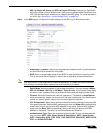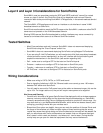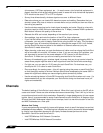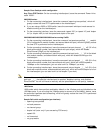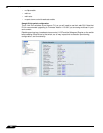
SonicPoint Deployment Best Practices
531
SonicOS 5.8.1 Administrator Guide
Layer 2 and Layer 3 Considerations for SonicPoints
SonicWALL uses two proprietary protocols (SDP and SSPP) and both *cannot* be routed
across any layer 3 device. Any SonicPoint that will be deployed must have an Ethernet
connection back to the provisioning SonicWALL UTM appliance, in the same broadcast domain/
network.
The SonicWALL UTM appliance must have an interface or sub-interface in same VLAN/
broadcast domain as SonicPoint.
SonicPoints must be able to reach the DHCP scope on the SonicWALL; make sure other DHCP
servers are not present on the VLAN/broadcast domain.
Sharing SSIDs across SonicPoints attached to multiple interfaces may cause connectivity
issues as a wireless client roams to a different SonicPoint subnet.
Tested Switches
• Most Cisco switches work well; however SonicWALL does not recommend deploying
SonicPoints using the “Cisco Express” switch line.
• SonicWALL does not recommend deploying SonicPoints using Netgear PoE switches.
• If you are using D-Link PoE switches, you will need to shut off all their proprietary broadcast
control and storm control mechanisms, as they will interfere with the provisioning and
acquisition mechanisms in the SonicPoint (see section regarding this).
• Dell – make sure to configure STP for fast start on SonicPoint ports.
• Extreme – make sure to configure STP for fast start on SonicPoint ports.
• Foundry – make sure to configure STP for fast start on SonicPoint ports.
• HP ProCurve – make sure to configure STP for fast start on SonicPoint ports.
Wiring Considerations
• Make sure wiring is CAT5, CAT5e, or CAT6 end to end.
• Due to signaling limitations in 802.3af, Ethernet cable runs cannot go over 100 meters
between PoE switch and SonicPoint.
• You will need to account for PoE power loss as the cable run becomes longer; this can be
up to 16%. For longer cable runs, the port will require more power to be supplied.
Site Survey and Planning
• Conduct a full site-walk of all areas SonicPoints will be deployed in with a wireless spectrum
scanner; note any existing APs and the channels they are broadcasting on. SonicWALL
currently recommends using Fluke or AirMagnet products to conduct full site surveys. You
may also wish to try out NetStumbler/MiniStumbler, which while free does a decent job of
surveying, providing it works with your wireless card.
• Blueprints of floor plans are helpful; here you can mark the position of Access Points and
the range of the wireless cell. Make multiple copies of these as during the site-survey
results may cause the original design not to be the best and a new start will be needed. As
well you see where walls, halls and elevators are located, that can influence the signal.
Also, areas in which users are located – and where not - can be seen. During the site-
survey keep an eye open for electrical equipment that may cause interference



